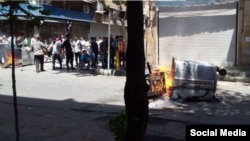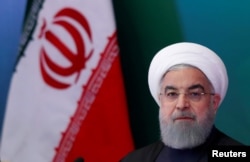Iranians angered by their nation's worsening economy staged a second day of street protests in Tehran on Tuesday, although on a smaller scale than the previous day's anti-government demonstrations.
Images posted on social media and verified by VOA Persian showed garbage cans set on fire in the narrow streets of Tehran's Laleh Zar district. The images include a video clip posted on YouTube by an overseas-based Iranian pro-labor union group, Iran Kargar.
WATCH: Iranian protesters set fire to garbage cans in Tehran's Laleh Zar district, June 26, 2018.
In another video clip published by BBC Persian, emergency workers attended to two wounded men who apparently had been beaten by police in the area. Iranian state media also reported the closure of a nearby Tehran metro station during the protest.
Hundreds of Iranians had marched through major streets of central Tehran on Monday to protest poor economic conditions, including the rial's slump to a record low of 90,000 to the dollar on the black market. It was the biggest anti-government protest in Tehran since similar economic grievances triggered mass demonstrations in 2012.
Monday's protest began in Tehran's Grand Bazaar, where many merchants closed their stores and marched toward Iran's parliament, chanting anti-government slogans. Police fired tear gas to try to break up the marches.
Iranian state media said most stores in the Grand Bazaar operated normally on Tuesday, although some gold and jewelry shops remained closed, as their owners went on strike for a second day. Social media posts monitored by VOA Persian said bazaar workers also went on strike in the western city of Kermanshah and the southern city of Shiraz.
In a precursor to Monday's unrest, mobile phone store owners went on strike in two of the capital's major markets on Sunday.
Shopkeeper: We weren't forced
In Tuesday's edition of VOA Persian's Straight Talk call-in show, many callers said they were in Tehran and had participated in the protests, which they urged other people to join.
One man who gave his name as Alireza said he and other striking shopkeepers were dissatisfied with the economic situation and chose to do something about it by closing their doors voluntarily. He rejected reports that protesters forced some shopkeepers to go on strike.
Many Iranian shop owners have reacted angrily to the rial's slump against the dollar, as it raises their costs of importing products and pressures them to dramatically increase prices for consumers.
The Iranian currency has lost 50 percent of its value against the dollar on the black market in the past six months. Tehran set an official exchange rate of 42,000 rials to the dollar in April, but illicit trading has continued.
In a nationally televised speech Tuesday, Iranian President Hassan Rouhani tried to reassure the public, saying the economic situation was not as bleak as it appeared. He also blamed the currency crisis on enemy powers, including the United States, who he said have been waging an economic and psychological war against Iran.
The United States began the process of reimposing tough economic sanctions on Iran last month as part of its decision to withdraw from the 2015 Iran nuclear deal.
Former Iranian President Abolhassan Bani Sadr, who lives in exile in France, told VOA that he doubted the reimposition of sanctions on Tehran was behind the Iranian economic crisis. He blamed the government's internal political disputes, saying a "military-economic Mafia" is deliberately provoking a crisis in order to seize power and force new presidential elections. Bani Sadr said the forces behind this strategy wanted to maintain their authority during the upcoming succession of Iran's aging supreme leader, Ayatollah Ali Khamenei.
Speaking to VOA Persian's NewsHour program on Tuesday, Iranian dissident Nazila Golestan, a Paris-based political officer of the Iran National Council for Free Elections, said regardless of whether the Iranian Islamist establishment's conservatives or reformists have been in power, the government has been unable to fulfill the Iranian people's desires.
Nationwide scope seen
"People are just fed up," Golestan said. "Sooner or later, this protest [in Tehran] will become a nationwide movement and lead to the regime's dissolution."
In an interview with VOA Persian's Early News show earlier Tuesday, Baltimore-based economist Steve Hanke of Johns Hopkins University said Iran's main problem was what he called the "tiny" private sector in an economy largely controlled by the government and its allies.
"The restrictions on entrepreneurship and private business in Iran are onerous," Hanke said. "The private sector has been completely squeezed out."
The latest annual ranking of economic freedom around the world by the U.S.-based Cato Institute research group placed Iran as one of the least free, at 150th out of 159 nations.
Cairo correspondent Ed Yeranian and Behrooz Samadbeygi of VOA's Persian service contributed to this report.











